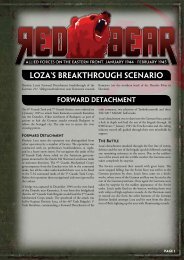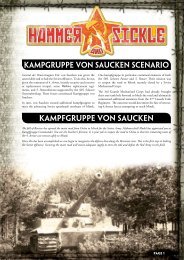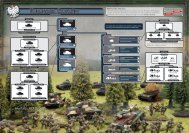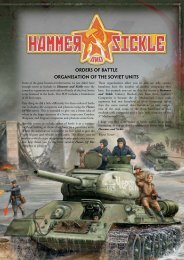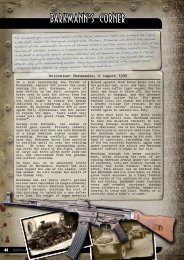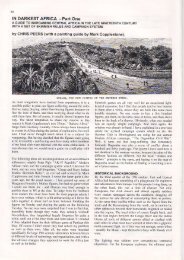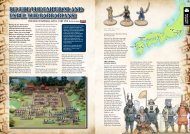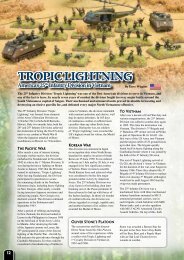Finns in Lapin Sota (PDF)... - Flames of War
Finns in Lapin Sota (PDF)... - Flames of War
Finns in Lapin Sota (PDF)... - Flames of War
You also want an ePaper? Increase the reach of your titles
YUMPU automatically turns print PDFs into web optimized ePapers that Google loves.
and pushed the <strong>F<strong>in</strong>ns</strong> back a short distance along the roads<br />
to Muonio and Kemi. Only when 11 th Division and the artillery<br />
<strong>of</strong> both divisions had been shipped <strong>in</strong> could the <strong>F<strong>in</strong>ns</strong><br />
rega<strong>in</strong> <strong>in</strong>itiative and press further, surround<strong>in</strong>g the MG Ski<br />
brigade. The battle <strong>of</strong> Tornio ended on 8 October when<br />
the surrounded German brigade broke <strong>of</strong>f the encirclement<br />
with heavy losses. Kampfgruppe Tornio had already been<br />
ordered to withdraw on 7 October.<br />
Meanwhile 15 th Brigade advanc<strong>in</strong>g from Oulu attacked<br />
Kemi. It tried to surround the two German battalions<br />
there, but a German counterattack broke the encirclement<br />
and most escaped. Kemi was secured on 8 October. The<br />
Panssari Division and 6 th Division had started to advance<br />
towards Rovaniemi on 1 October. To clear the command<br />
structure Siilasvuo comb<strong>in</strong>ed the divisions <strong>of</strong> III Corps <strong>in</strong>to<br />
two major groups, Group Lagus with Panssari Division and<br />
6 th Division and Group Pajari with 3 rd and 11 th Divisions.<br />
In reprisal for the attacks, the German northern army<br />
adopted scorched earth tactics. Everyth<strong>in</strong>g was boobytrapped,<br />
build<strong>in</strong>gs were burned, roads were m<strong>in</strong>ed and<br />
destroyed and anyth<strong>in</strong>g even resembl<strong>in</strong>g a bridge was blown<br />
up. With the arctic w<strong>in</strong>ter approach<strong>in</strong>g and the need for<br />
shelter critical, this would prove a bitter blow to local civilians,<br />
who would suffer great hardship <strong>in</strong> the w<strong>in</strong>ter <strong>of</strong><br />
1944-45.<br />
Dur<strong>in</strong>g the battles at Kemi and Tornio, Group Lagus,<br />
spearheaded by the Jääkäri Brigade, cont<strong>in</strong>ued to advance<br />
towards Rovaniemi fight<strong>in</strong>g German rearguards. Group<br />
Pajari sent 11 th Division towards Muonio to the north while<br />
3 rd Division and 15 th Brigade were directed to Rovaniemi.<br />
However, many difficulties would beset the pursuers. The<br />
roads were few and had many unbridged<br />
creek cross<strong>in</strong>gs, and <strong>in</strong> any case all <strong>of</strong><br />
the bridges had usually been destroyed<br />
by Germans, so that the Sturmi assault<br />
guns and many other vehicles with<br />
low clearance had to be left beh<strong>in</strong>d.<br />
M<strong>in</strong>es were everywhere and cont<strong>in</strong>ued<br />
to cause casualties. F<strong>in</strong>ally the difficult<br />
nature <strong>of</strong> the northern terra<strong>in</strong> asserted<br />
itself, mak<strong>in</strong>g movement difficult,<br />
while the rocky slopes <strong>of</strong> northern<br />
hills made ideal block<strong>in</strong>g positions.<br />
Plentiful swamps and water obstacles<br />
made outflank<strong>in</strong>g and go<strong>in</strong>g around<br />
destroyed road sections difficult.<br />
The battles with the withdraw<strong>in</strong>g<br />
Germans usually followed the same<br />
frustrat<strong>in</strong>g pattern throughout the<br />
Lapland <strong>War</strong>. The Germans would set<br />
up a block<strong>in</strong>g position with a mobile<br />
rearguard <strong>of</strong> a couple <strong>of</strong> motorised<br />
<strong>in</strong>fantry battalions supported by strong<br />
artillery and pioneers. The position<br />
was flanked by a river (the roads <strong>in</strong><br />
Lapland usually ran parallel to one <strong>of</strong><br />
the plentiful rivers) on one side and<br />
was extended as far <strong>in</strong>to the wilderness<br />
as possible on the other. Furthermore,<br />
as the pursu<strong>in</strong>g <strong>F<strong>in</strong>ns</strong> were on foot it<br />
Source: <strong>Sota</strong>toimet p.290<br />
was easy to calculate the place <strong>of</strong> the block<strong>in</strong>g position so<br />
that the pursuers reached it <strong>in</strong> the even<strong>in</strong>g. On the destroyed<br />
roads most <strong>of</strong> the artillery was usually left far beh<strong>in</strong>d so there<br />
was no choice but to try and go around the position. When<br />
the flank<strong>in</strong>g force got to a threaten<strong>in</strong>g position dur<strong>in</strong>g the<br />
night the Germans simply boarded their trucks and left<br />
to establish another position where the same game started<br />
all over aga<strong>in</strong>. Destroyed bridges were kept under artillery<br />
and rocket fire for as long as possible so that repairs started<br />
late. Comb<strong>in</strong>ed with the destroyed and m<strong>in</strong>ed roads this<br />
meant that heavy equipment and supply columns were left<br />
far beh<strong>in</strong>d <strong>of</strong> the advanc<strong>in</strong>g <strong>in</strong>fantry while the broken roads<br />
took a heavy toll on the already worn trucks.<br />
At Portimojärvi Group Lagus met German defensive<br />
position built for protect<strong>in</strong>g Rovaniemi. It was defended by<br />
Gebirgsjäger Regiment 218 from 7. Gebirgsdivision, charged<br />
with keep<strong>in</strong>g the <strong>F<strong>in</strong>ns</strong> on the south side <strong>of</strong> River Kemi until<br />
at least 14 October. Jääkäri Battalions 2, 3 and 4 were sent<br />
to outflank the German position from the west while Jääkäri<br />
Battalion 5 would advance to contact the defensive position.<br />
The Jääkäri Battalions managed to cut the road to Rovaniemi<br />
but soon started to run low on ammunition as supply had to<br />
be carried through rough wilderness terra<strong>in</strong>. The Germans<br />
broke out to the north on 9 October. Group Lagus then cont<strong>in</strong>ued<br />
to advance fight<strong>in</strong>g the rearguards until the Germans<br />
withdrew to Rovaniemi and destroyed the Bridges <strong>of</strong> River<br />
Kemi beh<strong>in</strong>d them.<br />
F<strong>in</strong>nish troops were ordered to surround Rovaniemi to cut<br />
<strong>of</strong>f the German troops there. The vanguard <strong>of</strong> Group Lagus<br />
crossed River Kemi east <strong>of</strong> Rovaniemi and cut the railway<br />
to Kemijärvi. They could not cross River Ounas between



